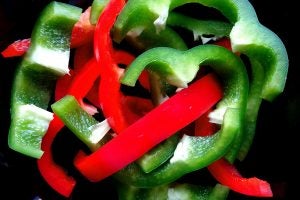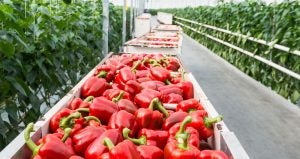When you think of bell peppers, your mind probably quickly goes to green and red bell peppers — and if you’re really an out-of-the-box thinker, yellow and orange bell peppers popped into your brain! While there are certainly different varieties of bell peppers, all of those colors as you find them in a typical grocery store — and especially those two main colors you likely thought of, the green and red bell peppers — can come from the same plant, just at different stages of ripeness. Green is the produce at its unripe stage, while it can morph to yellow and even orange before hitting its ripest stage at red.
It was a revelation to me, and it was only recently that I learned this. I had gone to my local greenhouse and plant sale to support Pete and Natasha, a small farm in my area of Iowa.
Me: I am planting my garden and would like a bunch of edible plants. What all do you have?
Natasha: <shows me around the greenhouse> Tomatoes, eggplant, carrots, kale, red bell peppers, jalapeños …
Me: OK, red peppers and jalapeños. Got any green bell peppers?
Natasha: That’s a huge myth! Green peppers are just unripe red peppers.
Mind. Blown.
For anyone who knew this already, pardon my ignorance. I never claimed to be an expert in gardening. But, after having this conversation with Natasha, I realized I was not alone in peppery misunderstanding.
“It’s a common question that I get asked all the time,” she added.
I guess that’s a little bit of a relief.

So, I wanted to explore this more.
Ever notice that in the grocery store that green peppers tend to be less expensive than red ones? It’s because they’re younger and require fewer inputs to grow. On the flip side, their nutrients aren’t quite as developed either — though, it’s important to note that all peppers are excellent sources of vitamins A and C, potassium, folic acid, and fiber. Red peppers have almost 11 times more beta-carotene and 1.5 times more vitamin C than green ones and taste a little sweeter as well. Some even feel that green peppers may have a bit of a bitter taste.
That’s the funny thing with nutrition — popular myths and truths consistently swirl the food world. For example, everyone claims brown rice is nutritionally superior to white rice. While this is absolutely true, white rice is just brown rice with the bran removed. (Giving it the “stickier” consistency we crave with sushi.). So, if you consume brown rice, you’re technically consuming white rice as well because it comes from the same plants.
It gets even wilder when you consider peppers and tomatoes are fruits but nutritionally treated like a veggies; corn is technically a type of grass; and peanuts aren’t actually nuts. The world of plant botany is a really interesting and confusing one after you dive in deep on the science!
But, let’s get back to peppers! The origins of bell peppers can be traced to Mexico, Central America, and South America, where they were sought-after by explorers hoping to make black pepper.
Of course, since then, they’ve become a staple of American gardens and are produced commercially across the U.S. According to University of California-Davis, the top bell pepper states in the U.S. are California, Florida, Georgia, New Jersey, Ohio, North Carolina, and Michigan, and the U.S. ranks fifth in the world for green pepper production.
When you harvest a bell pepper, the skin should be firm and the stem fresh and green. And, keep an eye out for soft spots on the pepper or signs of wild. University of Illinois Extension has a great guide on what varieties to choose, when and how to plant, when to harvest, and what kinds of pitfalls you may encounter.

Are you growing peppers in your garden? I purchased a couple of plants and hope for a good turnout. Yet, even if they don’t do well, I can always trust my local grocer. A big thanks goes to the farmers that grow them commercially so we can enjoy them year-round!
Michelle Miller, the Farm Babe, is an Iowa-based farmer, public speaker, and writer, who lives and works with her boyfriend on their farm, which consists of row crops, beef cattle, and sheep. She believes education is key in bridging the gap between farmers and consumers.



